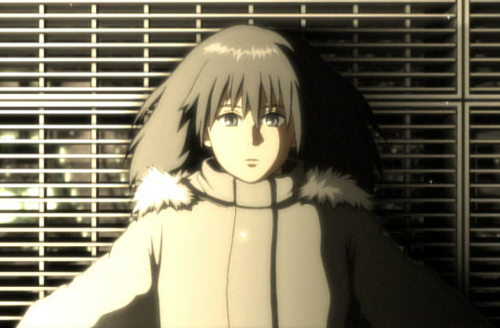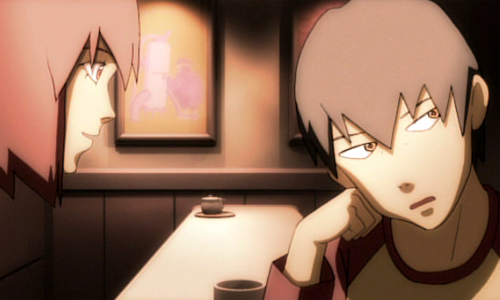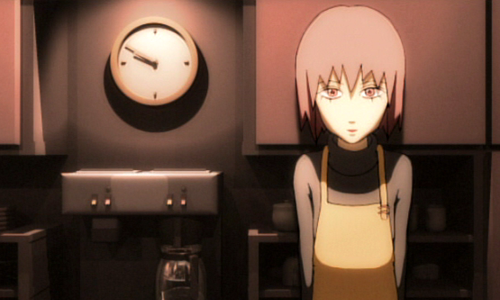It's often hard to see an independent spirit in anime, considering how much of it's disposable fluff for children and teenagers and genuinely broken nerds. Yet amid all the toy commercials, the abortive experiments, and the creepy nonsense, there's occasionally someone like Makoto Shinkai, the young upstart who shocked a great many in 2002 by making the deftly beautiful thirty-minute Voices of a Distant Star nearly all by himself. Shinkai has since moved on to directing fully professional films like The Place Promised in Our Early Days and 5 Centimeters Per Second, but he's at least left the door wide open for other solitary mavericks and their creations. Yasuhiro Yoshiura's Pale Cocoon may be the best among them.
Pale Cocoon offers only vague hints of what ruined the world, but the aftermath is clear: mankind has retreated to live in a shell of orbital colonies wrapped around the planet. Life is stable but bleak, or at least that's the case in Archive Excavation Department 092, an obscure government division charged with restoring degraded data files from the world below.
Yet the department itself is falling apart. Once a thriving center of research, it's shrinking as workers move to lower levels, and only a devoted few remain. Ura, a contemplative young data sifter, sticks around simply because he's fascinated by the unspoiled Earth seen in his grainy reassemblies of twentieth-century deserts, fields, and factories. His sole fellow holdout is Riko, a soft-spoken analysis technician who spends much of her empty workday lying at the base of a massive stairwell. She sticks around because Ura does.
Ura's devotion pays off when he's sent some half-salvaged footage depicting a library and a strange woman. Video files are a rarity in his profession, and that's all the reason he needs to dig himself in deeper. He also drifts even further from Riko, who all but begs him to leave the department with her.

|
|
Riko stares into space enough to qualify as an honorary Mamoru Oshii character.
|
Pale Cocoon can't escape comparisons to Shinkai's Voices of a Distant Star, as they're both tales of tortured relationships framed by science fiction tropes. Yet they're radically different stories. While Shinkai's work is bright, colorful and rigidly earnest, Pale Cocoon is far gloomier, and a shade more realistic. The main couples of Voices and every other Shinkai film are torn apart by circumstance, yet Ura and Riko have little to blame but their own inner failings. Far from the vivid locales of Shinkai's fables, theirs is a dim, antiseptic world of interactive LCD screens and empty corridors, made all the more artificial by the occasional recovered flash of a verdant field or blue sky.
For all of its oppressive air, Pale Cocoon's still beautiful. Though he's working on a slim budget, Yoshiura's use of light and shadow is stunning, as are the various background touches; Ura's computer screens show more thoughtful details than the whole of some animated films. Yoshiura also avoids the usual claustrophobia of futuristic orbital colonies by using vast areas of space and steel to map an emptiness that's even more depressing. His eye for subtle storytelling is a refreshing change, and a single dialogue-free montage of Ura and Riko's work week says more about their frayed connections than reams of narration ever could.
But Pale Cocoon isn't really about limitless despair and anomie. It takes many cues from older science fiction, and Ura's search for the real Earth is nothing more grand than a conflict of ideas. Like the heroes of countless short stories about stifled futures, Ura and Riko must choose between a dangerous truth and comfortable ignorance, with Ura's blunt obsession removing any middle ground.
It doesn't promise a happy ending, but there's a hopeful note in the final shot, just as there's a curiously upbeat tinge to the bagpipes-flavored harmonies of the soundtrack. As in Shinkai's works, Pale Cocoon also includes an airy pop song, but it's more than ambience. The music and its source figure nicely into the climax, and their initially shallow tone is all part of the impact.
Yoshiura's vision isn't without fault. The few hints about Earth's fate smack of tiring environmentalism, so it's a good thing that they're only hints. Ura and Riko are also a bit too blank and restrained in their animation, and too nondescript in their voice acting. Instead of blushing schoolchildren, they're on the fading end of a relationship, and their romance is less a celebration than a funeral. Silent implications can work wonders, but perhaps these two would't be drifting apart at all if they'd just fucking talk to each other.
Pale Cocoon can be too elegiac at times, but it's a wonderful sign, and not just because it's an artful, engaging story from a director barely out of the gate. It's also proof that Shinkai wasn't a once-in-a-decade breakout, and that there's still a wealth of potential in the amateur anime circuit. It's okay if the industry around it makes distasteful pabulum and easily ignored mediocrities aplenty, just as long as something like Pale Cocoon comes along once in a while.
Aquatic Language
Pale Cocoon isn't yet available in North America, but its Japanese DVD release is highly accessible for import buyers. It's surprisingly cheap at 2940 yen (about $22) and comes complete with English subtitles and Yoshiura's earlier work, the nine-minute Aquatic Language.

|
|
Our protagonist struggles to keep up a discussion with a disembodied head. I'm not being entirely facetious about that. I'm being edgy and arty and subtle as fuck and someone should give me a fat indie cartoon contract right now.
|
The short finds a young man in a café, moping over a breakup and disaffectedly hitting on the sympathetic girl behind the counter. The conversations around them shift from two young women talking about nothing in particular to two thuggish artistes debating the nature of language and living paintings.
Oddly enough, there's an English track for Aquatic Language. It's generally flat and awkward, with the only passable performance coming from the counter girl's actress. At least it's translated fairly well, despite a glaring spelling mistake about "peple."
|
|

|
|
Gee, I wonder if Yoshiura spends a lot of time in coffee shops.
|
It's a strange little student-caliber film. The dialogue's shallow, perhaps intentionally so, and Yoshiura tries to enliven it with constant cuts and flamboyantly off-kilter viewpoints. The results are pretentious and often muddled, touching on the laws of robotics, the nature of relationships, and the impermanence of dull chatter, all without really saying that much.

|
|
Yes, it's an art-house version of Futurama's "DON'T DATE ROBOTS" clip.
|
By the end, however, Yoshiura finds an interesting moment. There's a pretty musical interlude, and then a glance at a failed meeting. It turns Aquatic Language into a thoughtful piece and another promising sign from Yoshiura. If he improved so much between Aquatic Language and Pale Cocoon, his next work, Eve no Jikan, should be phenomenal.